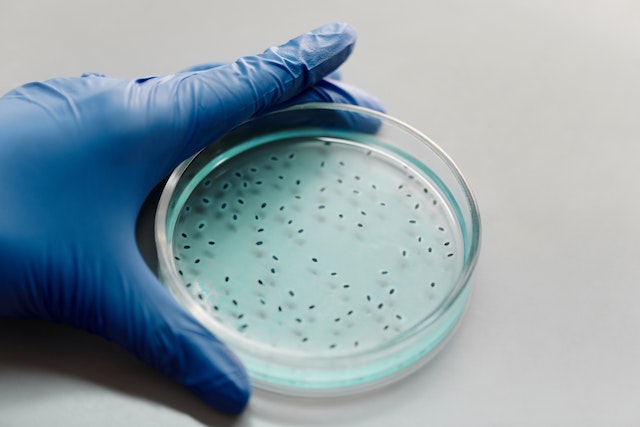
What is botulism? Botulism is an illness caused by a toxin that the Clostridium botulinum bacteria produces.
Clostridium botulinum is a very strong bacteria. They are usually found in the soil in spore form, but they grow very rapidly on the surface of fruit, vegetables, seafood, meat, and any kind of food. They like a warm, low-oxygen environment to grow in. If the environment is too harsh for them, they can release spores in order to survive. The spores are harmless to us, but they can spread the bacteria to other foods, where they can start growing again. The spores are much stronger than the bacteria themselves and they can survive being in boiling water and no oxygen environments. Because of this, when foods are canned, they are heated with high-pressure steam, which can be well above 100 ˚C and which can kill the spores.
We can eat many bacteria and a lot of them are actually good for us, but Clostridium botulinum is not one of those. The problem is not the bacteria so much as the toxin it produces. Clostridium botulinum are harmless to us, but when they are in a very low-oxygen or zero oxygen environment, they release a toxin called botulinum toxin. This is one of the most potent toxins known. If we eat the bacteria and this toxin, our stomach acid is not enough to destroy it. The toxin can very easily pass through our stomach lining and into our bloodstream. Once it is there, it starts to do its damage.
Botulinum toxin is a nerve toxin and once in the bloodstream it stops the nerve system working properly. The toxin travels through the blood to the muscles and binds with the nerve endings that join the muscles. When it is there, it can remove some of the proteins that the nerve needs to send signals to and from the brain. This means the brain can’t tell the muscles to contract, which paralyzes the person. The first symptoms of botulism are dizziness, muscle weakness, drooping eyelids, slurred speech, breathing difficulties, and difficulty swallowing. All of these things are caused by the neurotoxin preventing the nerves from firing and contracting the muscles.
Botulism is survivable if treated. If it is not treated, it can be fatal because the toxins spread to the diaphragm and stop the lungs from working. Most deaths from botulism are from respiratory failure. If treated, hospitals can inject antitoxins to neutralize the botulinum toxin. They can also use ventilators and other equipment to support the body until the toxin is eliminated.
How do we get the neurotoxin inside us? People become infected by the botulinum toxin in three different ways. The first, foodborne botulism, is the most common. This is when we eat food that is infected with the bacteria after it has produced its toxin. When food is canned, it is usually heated to a temperature high enough to kill the bacteria and the spores, but improperly canned food might not be heated enough. This can leave living spores inside the can, which has almost no oxygen. When the can is placed in a warm environment, the spores begin to grow and release the toxin because there is no oxygen. The toxin can be killed if the contents of the can are boiled at 100 ˚C for over ten minutes, but most people don’t do that before they eat. Ready-meals can be a problem as well. They could have botulinum toxins in them, but people don’t cook or microwave them for long enough to destroy the toxin.
The second way is through wounds. Clostridium botulinum spores can be blown by the wind and they can land on open wounds. If that happens, they can be trapped in the wound where there is no oxygen and produce their toxin. This is very rare. Another way this can happen is if drug addicts inject themselves with a needle that has botulinum on it. This puts it into the muscle and it produces its toxin.
The third way is in infants. It is also rare, but infants can ingest the bacteria spores and the spores can start to germinate in their intestines, releasing toxin. This doesn’t happen in children over about one year old because our bodies develop defenses to stop spores germinating inside us.
There is actually a fourth way we can get the botulinum toxin inside us and it is intentionally. Anybody that has been injected with Botox has the botulinum toxin inside them. Botox is a drug made using a small amount of the toxin. When it is injected into the face muscles, it causes the same paralysis as with botulism and stiffens up the face. Our bodies can overcome it in time, so Botox injections have to be repeated. If used for a long period of time, Botox injections can cause permanent facial damage. That’s not surprising as it is a very strong neurotoxin. And this is what I learned today.
Photo by Edward Jenner: https://www.pexels.com/photo/photo-of-a-person-with-a-blue-glove-holding-a-petri-dish-4031367/
Sources
https://www.nhs.uk/conditions/botulism/
https://en.wikipedia.org/wiki/Clostridium_botulinum
https://www.fsis.usda.gov/food-safety/foodborne-illness-and-disease/pathogens/clostridium-botulinum
https://en.wikipedia.org/wiki/Botulinum_toxin
https://www.who.int/news-room/fact-sheets/detail/botulism
https://www.frontiersin.org/articles/10.3389/fmicb.2016.00042/full
